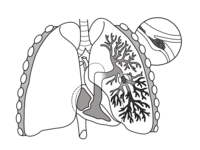
Photo from wikipedia
Normally, ipsilateral hemodynamic compromise of patients with carotid stenosis (CS) is subjectively identified by collateral circulation through cerebral angiography in the clinical process. It is unclear whether collaterals would linearly… Click to show full abstract
Normally, ipsilateral hemodynamic compromise of patients with carotid stenosis (CS) is subjectively identified by collateral circulation through cerebral angiography in the clinical process. It is unclear whether collaterals would linearly determine cerebral perfusion in CS patients. This study aimed to investigate the independent role of collateral circulation on cerebral perfusion in CS patients and the underlying interrelations among them. From 2017 to 2020, 124 CS patients who underwent carotid endarterectomy (CEA) with both preoperative CTP and digital substruction angiography (DSA) images were enrolled. Division of subgroups was based on degree of CS (50–70%, 70–90%, and near-occlusion (NO)) and grades of collateral circulation by DSA. Differences in CTP parameters between CS patients with different collateral circulation were analyzed. Among 124 CS patients, grades 2 and 3 were highly associated with carotid NO (n = 22, 32.35% and n = 22, 32.35%) compared with others (P < 0.0001). The collateral circulation was found to have poor relation with cerebral perfusion parameters in all enrolled patients but significantly improved ipsilateral cerebral perfusion in patients with carotid NO (P < 0.05). Linear hemodynamic compromise was barely related to degree of CS in lobes supplied by middle cerebral artery (MCA) except the frontal lobe (P < 0.05). The grades of collateral circulation are positively associated with degree of CS while having nonsignificant effect on cerebral perfusion. Overall, severity of CS is poorly related to hemodynamic status while the perfectibility of compensation defined by grades of collateral circulation effectively alleviates ipsilateral cerebral perfusion deficit in carotid NO.
Journal Title: Journal of Healthcare Engineering
Year Published: 2022
Link to full text (if available)
Share on Social Media: Sign Up to like & get
recommendations!